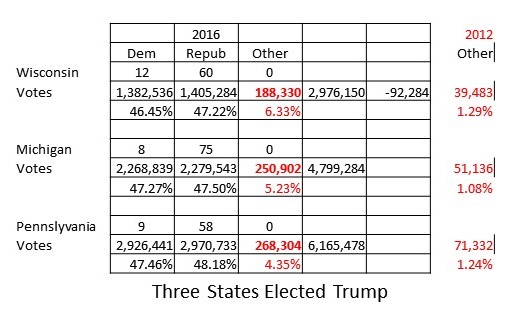This is not 2016 and Trump got one hell of a shellacking from Harris in the debate. She was smiling . . . This forecast by Nate Silver seems to me to be a bit optimistic. about Trump in the lead with 60-something percent. After Trump’s debate performance with Kamala Harris, I do not see Trump winning. If he does, it will be slight. I still would not ignore Trump. We did one time before, thinking our vote would be funny. Against Hillary Clinton, Trump’s win was not overwhelming. Indeed, he slipped by, by the narrowest of margins. Much of this occurred in three states which had an overwhelming vote for others which included Mickey Mouse, Donald Duck, next door neighbor, etc. In all three states the percentages putting Trump over the top were
Topics:
Bill Haskell considers the following as important: 2024 election, politics, Trump
This could be interesting, too:
Robert Skidelsky writes Lord Skidelsky to ask His Majesty’s Government what is their policy with regard to the Ukraine war following the new policy of the government of the United States of America.
Joel Eissenberg writes No Invading Allies Act
Ken Melvin writes A Developed Taste
Bill Haskell writes The North American Automobile Industry Waits for Trump and the Gov. to Act
This is not 2016 and Trump got one hell of a shellacking from Harris in the debate. She was smiling . . .
This forecast by Nate Silver seems to me to be a bit optimistic. about Trump in the lead with 60-something percent. After Trump’s debate performance with Kamala Harris, I do not see Trump winning. If he does, it will be slight.
I still would not ignore Trump. We did one time before, thinking our vote would be funny.
Against Hillary Clinton, Trump’s win was not overwhelming. Indeed, he slipped by, by the narrowest of margins. Much of this occurred in three states which had an overwhelming vote for others which included Mickey Mouse, Donald Duck, next door neighbor, etc. In all three states the percentages putting Trump over the top were less than 1%. The numbers voting for others were 4 to 6 times higher than in 2012.
See the attached chart (below) I developed back then. I was nosey in 2016 as compared to 2012. In 2020, the vote for others returned to something close to normal. Sometimes when you tell a story, one’s reputation can make it more real than what it should be. Even if it is close and Trump wins, Nate’s reputation will suffer for his forecast.
Weeks before the election in 2016 we (Michigan) knew we were in trouble. Those who voted for others did not. They thought it was funny. The Michigan Dems were not answered with help. They were ignored. Then too, I wonder whether those who voted for “others” regret voting for pets, cartoon characters, etc. Just like stepping in dog feces, no matter how hard you scrapped your shoe against a Chicago city curb, you can never get it completely off the sole of your shoe. Even if you succeed in getting some of it off. the smell lingers.
Here we are in 2024 dealing with the same feces on our shoes and the smell lingers in the form of Trump.
The below partial article is taken from Washington Monthly (Bill Scher). The depicted Excel spread sheet belongs to myself.
~~~~~~~
Probabilistic Election Forecasts Are Stupid and You Should Not Look at Them, Washington Monthly.
Last week as his (Nate) Silver Bulletin forecast (he no longer runs FiveThirtyEight) gave Trump a chance of winning above 60 percent. He crossed the 50 percent threshold in the previous week. As of today, Trump’s chances sit at 61.3 percent.
Several other folks are in the probabilistic forecasting game to include FiveThirtyEight, The Hill, The Economist, Brown Political Review, Race to the WH, and JHK Forecasts. None of these give Trump the edge, and most put Harris’s percent chance of winning in the mid-50s.
This doesn’t mean the Harris ones are right and the Trump one is wrong, or vice-versa. All of these models show that the race is extremely close and could go either way.
“We had him with a 30 percent chance [28.6 percent to be precise] and that’s a pretty likely occurrence.” That’s what Silver said about Trump and his forecast after the 2016 election, arguing he should get credit for not fully counting Trump out, when other forecasts essentially did.
Fair enough, but such emphasis on uncertainty certainly would be useful today, with all forecasts showing an even closer race.
Most importantly, we don’t need probabilistic models to tell us about uncertainty. A simple averaging of state and national polls—with repeated reminders about how all polls are only snapshots of a fluid electorate and come with margins of error—would tell us the same, and with less confusion.
And if you don’t like how Real Clear Politics or FiveThirty Eight or The New York Times or the Washington Post handle their poll averages, you could do your own using the polls you deem of good enough quality. It’s not complicated.
But you’ll get the same story: The 2024 presidential election is an extremely close race that could go either way. Because pretty much every national and battleground state poll, and even a few non-battleground state polls, is within the margin of error.
Probabilistic forecasting came with an implicit promise that it is better than a simplistic reliance on polls.
Silver first became a major figure in the 2008 primaries when, as an anonymous blog poster, he predicted the outcomes of several late-season Democratic primaries without the use of polls by extrapolating demographic vote preference data from earlier 2008 primaries and results from previous years. This raised interesting questions about the value of polls.

